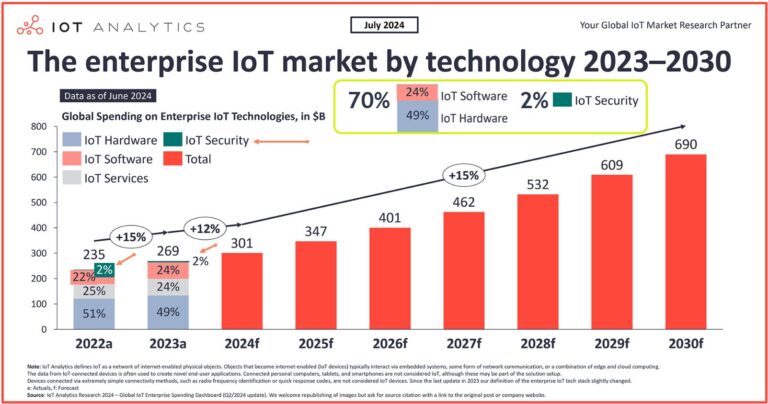𝐀𝐧𝐨𝐭𝐡𝐞𝐫 (my) 𝐀𝐧𝐚𝐥𝐲𝐬𝐢𝐬 𝐨𝐟 𝐭𝐡𝐞 𝐄𝐧𝐭𝐞𝐫𝐩𝐫𝐢𝐬𝐞 𝐈𝐨𝐓 𝐌𝐚𝐫𝐤𝐞𝐭 𝐛𝐲 𝐓𝐞𝐜𝐡𝐧𝐨𝐥𝐨𝐠𝐲 𝟐𝟎𝟐𝟑–𝟐𝟎𝟑𝟎
The IoT Analytics chart highlights several important trends and potential issues in the enterprise IoT market:
𝐑𝐚𝐩𝐢𝐝 𝐆𝐫𝐨𝐰𝐭𝐡 𝐢𝐧 𝐈𝐨𝐓 𝐒𝐩𝐞𝐧𝐝𝐢𝐧𝐠:
▫ IoT Hardware and Software: Significant investment and growth in IoT hardware (𝟒𝟗%) and software (𝟐𝟒%) indicates a strong focus on developing and deploying new IoT devices and applications.
▫ Projected Growth: The total spending on IoT technologies is projected to grow from $235 billion in 2022 to $690 billion by 2030, indicating a compound annual growth rate (CAGR) of around 15%.
Negligible Investment in IoT Security.
▫ Low-Security Investment: Despite the rapid growth in IoT hardware and software, only (𝟐%) of the spending is allocated to IoT security. This disproportionate investment raises concerns about the potential security risks associated with the proliferation of IoT devices.
▫ Security Gaps: The minimal investment in IoT security suggests that many vulnerabilities may go undetected and unaddressed, exposing the entire IoT ecosystem to potential threats.
To address this imbalance, organizations must (𝐀𝐂𝐓): 𝐀lignment with industry standards, 𝐂larity in security protocols, and 𝐓ransparency in security practices are essential to mitigate the risks associated with the rapid growth of #IoT technologies. By prioritizing #security, organizations can protect their IoT infrastructure, safeguard user #data, and ensure the #resilience of their operations in our increasingly connected world.
𝗡𝗼𝘁𝗶𝗰𝗲: The views within any of my posts, or newsletters are not those of my employer or the employers of any contributing experts. 𝗟𝗶𝗸𝗲 👍 this? feel free to reshare, repost, and join the conversation.



